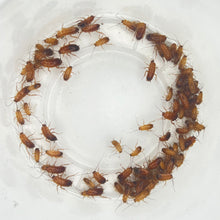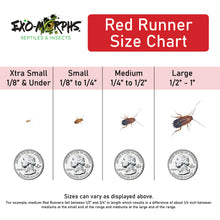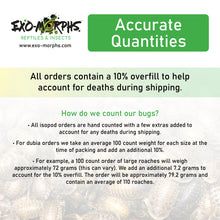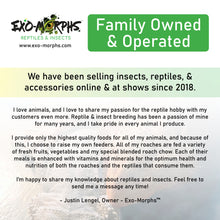
Red runner roaches, also known as Turkestan roaches or rusty reds, have the scientific name Blatta lateralis. They are small, fast-moving roaches that are commonly used as feeders for reptiles. Adult red runners reach about 1 inch in length, while the nymphs (especially the extra small ones) are tiny, usually around 1/8 to 1/4 inch. Adult males are reddish-brown with wings, while females are darker and wingless. These roaches are fast runners, which is why they're called red runners. They reproduce quickly, don’t produce much odor, and cannot climb smooth surfaces, making them easier to keep. Male red runners may flutter but generally don’t fly.
As feeders, they are high in protein and low in fat. Their soft bodies make them easy to digest, and their quick movement tends to trigger a strong feeding response in reptiles. Extra small red runners are ideal for hatchlings, small reptile species, and insectivorous reptiles.
Reptiles that commonly eat extra small red runner roaches include:
-
Geckos: Leopard geckos (especially hatchlings and juveniles), crested geckos, gargoyle geckos, day geckos, African fat-tailed geckos, and dwarf geckos like Lygodactylus species.
-
Anoles: Green anoles, brown anoles, and other small arboreal species.
-
Small or baby snakes: Rough green snakes, Dekay's brownsnakes, and hatchling insectivorous snakes such as some garter snakes.
-
Small turtles: Hatchling musk turtles, mud turtles, and young box turtles.
-
Other insectivorous reptiles and amphibians: Baby bearded dragons, fence lizards, young skinks (such as blue-tongue skinks), and also some amphibians like dart frogs, gray tree frogs, and baby pacman frogs.
When feeding red runner roaches to reptiles, it’s important to gut-load the roaches with nutritious food 24 hours before offering them. You should also dust them with a calcium or multivitamin supplement as appropriate for your reptile’s dietary needs. Make sure the size of the feeder insect is appropriate for your pet—generally, it should be no larger than the space between your reptile’s eyes. Also, keep an eye on uneaten roaches, as red runners can be fast and may stress out more passive or shy reptiles.











